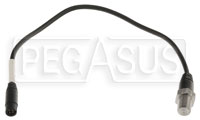Troubleshooting 101: AiM Sensors
A customer recently emailed for help with a mysterious temperature reading on his AiM dash. While composing a reply, we realized that the same troubleshooting steps could help save many more customers a lot of time and frustration.
The customer outlined the installation and described the odd reading, then asked a perfectly reasonable question:
Do I have a bad temp sensor?
It's possible! But it's worth checking a few other things before we jump to that conclusion. With shipping costs rising almost daily, we prefer not to ship the wrong replacement parts. And in this case, replacing the sensor would require the customer to partially drain, refill, and re-bleed his cooling system. He was even more hopeful than we were that the first step wouldn't be replacing the sensor!
A few details about this customer's installation are worth considering before we start.
He had two temp sensors, both the same PT-100 type (our Part No. MC-201), one reading Oil Temp (OT) and one reading Water Temp (WT).
Both sensors were configured the same way in Race Studio 3.
Both sensors were connected via a Channel Expansion Hub.
The oil temperature channel read normally, but the water temperature channel read a constant 600° F.
What do we know so far?
First, we know that both sensors are connected using a 719-to-712 adapter cable. That's the only way to connect to a Channel Expansion Hub.
We know that the Oil Temp sender, its adapter cable, its port in the hub, and the cable from the hub to the dash are OK. Otherwise he would not be getting a good OT reading.
We also know that the water temperature is not actually 600° F. How? Aside from the fact that the radiator hoses weren't melting, the AiM PT-100 temperature sensor tops out at 302° F. A reading of 600° F clearly indicates a problem!
We know that there are at least 3 parts that could be at fault: the Water Temp sender, its adapter cable, and (less likely) its port in the hub. We need to test each part to find the problem!
Let's start with the easy tests.
Here is where the fun begins. Yes, it can be fun -- IF you take a logical and methodical approach, and don't ever skip a test. The kiss of death for any troubleshooting exercise is saying "I know THAT part is good, so I won't do that test!" Skipping a test, for any reason, gives the actual problem a very comfortable place to hide.
In this case, because the two temp sensors were wired and set up exactly the same, it was logical to start at the Hub end of the extension cables. So the first step was to unplug the two extension cables from the hub, swap their positions, and plug them back in. In other words, connect the OT sensor to the WT port was and vice-versa.
If, as a result, the bad reading stayed on the WT channel (instead of following the sensor), then we could be certain that the problem was between the hub and the dash. Since the hub sends a digital signal "packet" to the dash, this problem would almost certainly be a bad connection on that port. But in this case, the problem followed the sensor. In other words, the OT channel was now reading 600° F. Remember, since we swapped just one end of the cables, the "Oil Temp" channel now was being fed water temp information by the WT sensor in the water jacket (and its original adapter cable).
The next diagnostic step is to leave the adapter cables in their new swapped positions in the hub, and swap the other ends of the cables between the two sensors (leaving the sensors where they are). This will return the Water Temp sensor back to the WT channel, but the two adapter cables have now been traded from one channel to the other. Now if the bad reading goes back to the WT channel, then we can give both adapter cables a clean bill of health, since each cable will have given a good reading coming from the Oil Temp sensor. That would point solidly to the Water Temp sensor. On the other hand, if the bad reading had stayed on the OT channel, then we would blame the adapter cable now connected to the OT sensor.
Just swapping the two adapter cables and testing at each step has given us a lot of information!
So... What was the problem?!?
We could not have asked for a better result.
After the first test (swapping hub ports), the bad reading switched to the OT channel. So the hub was OK, and the problem was either the sensor or its adapter cable.
While beginning the next test (swapping the cables between the sensors), the customer found that the extension cable had been pulled too hard and was disconnected from the Water Temp sensor. Reconnecting it corrected the temperature reading immediately.
How great is that? The fix was easy, free, and INSTANT. He didn't have to take anything else apart, and he didn't have to wait for a replacement part to arrive.
That illustrates another reason why we don't skip steps. Performing each test in order forces you to look at and touch everything, which gives you a great opportunity to find an issue that you might otherwise miss. If the loose connection had been at the hub, and we simply replaced the sensor, the problem would not have been fixed. We only would have succeeded in wasting several more days of his time.
What if I only have one temp sensor and one pressure (or linear travel) sensor?
You can perform the same troubleshooting steps above. As long as the two sensors are both analog (not digital -- you can't make a speed sensor act like a temp, pressure, or travel sensor), they will both provide a similar signal to the dash.
What if I only have one sensor?
The troubleshooting steps will be a little limited with just one sensor.
If you only have one sensor connected to an AiM system, then logically you also have at least one unused sensor port. Try connecting the sensor to a different port and see if you get a different reading. Note that some current AiM sensors are incompatible with some channels on older AiM dashes and loggers!
Connect the dash to your computer and use the Live Measures tab under the Connected Devices area in Race Studio 3 (the Online tool in Race Studio 2) to double-check if the dash display agrees with the sensor. If not, the issue is an error in the configuration.
While in Live Measures (or Online), click the "mV Values" button ("Show mV" button in Race Studio 2) to see if the dash is receiving a signal from the sensor at all. Alternatively, reset the sensor type on the questionable channel to "Generic linear 0-5V" with units from 0 to 5000 mV to see the raw voltage values displayed on the dash. This is a good option if you want to see the sensor values while road testing.
The mV range should be between 500mV and 4500mV. Zero mV indicates that the sensor is disconnected (possibly a broken wire inside a cable, possibly no reference voltage being sent to the sensor, possibly a bad sensor). Higher than 4500mV indicates a short circuit between the supply voltage and the signal wire. In this case, try unplugging the sensor, then the cable, working your way from the sensor back to the dash. When the reading drops to zero, you have just unplugged the culprit.
If the mV reading is reasonable (and if it changes in response to the sensor environment changing) but the reading on the dash does not make sense, check the configuration. Is the sensor type correct? Are the units correct? Do you have a math channel set up on that channel?
Once you are satisfied with your corrected configuration, be sure to Transmit the new configuration to the dash.


